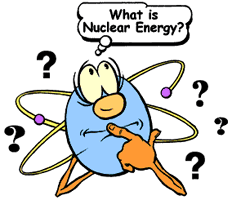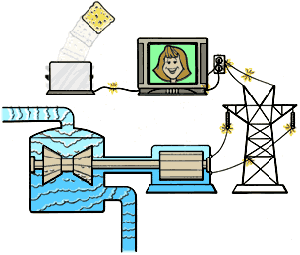

| NRC Home Page |
| Students' Corner |
| Teachers' Lesson Plans |
| About NRC |
| Glossary of Nuclear Terms |
| Basic References |
| Periodic Table of the Elements |
| Games |

Inside the NRC Video |
Nuclear energy is a way of creating heat through the fission process of atoms. All power plants convert heat into electricity using steam. At nuclear power plants, the heat to make the steam is created when atoms split apart -- called fission. (Other types of power plants burn coal or oil for heat to make steam.) The fission process take place when the nucleus of a heavy atom, like uranium or plutonium, is split in two when struck by a neutron. The "fissioning" of the nucleus releases two or three new neutrons. |
 |
|||||
| It also releases energy in the form of heat. The released neutrons can then repeat the process. This releases even more neutrons and more nuclear energy. The repeating of the process is called a chain reaction. In a nuclear power plant, uranium is the material used in the fission process. | ||||||
 |
The heat from fission boils water and creates steam to turn a turbine. As the turbine spins, the generator turns and its magnetic field produces electricity. The electricity can then be carried to your home, so you can work on the computer, watch television, play video games, or make toast! The U.S. Nuclear Regulatory Commission, also called the “NRC,” regulates nuclear power plants. We make sure they are safe for people who work there and live nearby, and for the environment. |
|||||
| The NRC also regulates nuclear material that is used in science, medicine and industry. We issue licenses to those who operate power plants or use nuclear material, and we inspect them to make sure they’re following our rules. DID YOU KNOW? Nuclear material is used for many things besides nuclear power:
|
||||||
|
||||||

